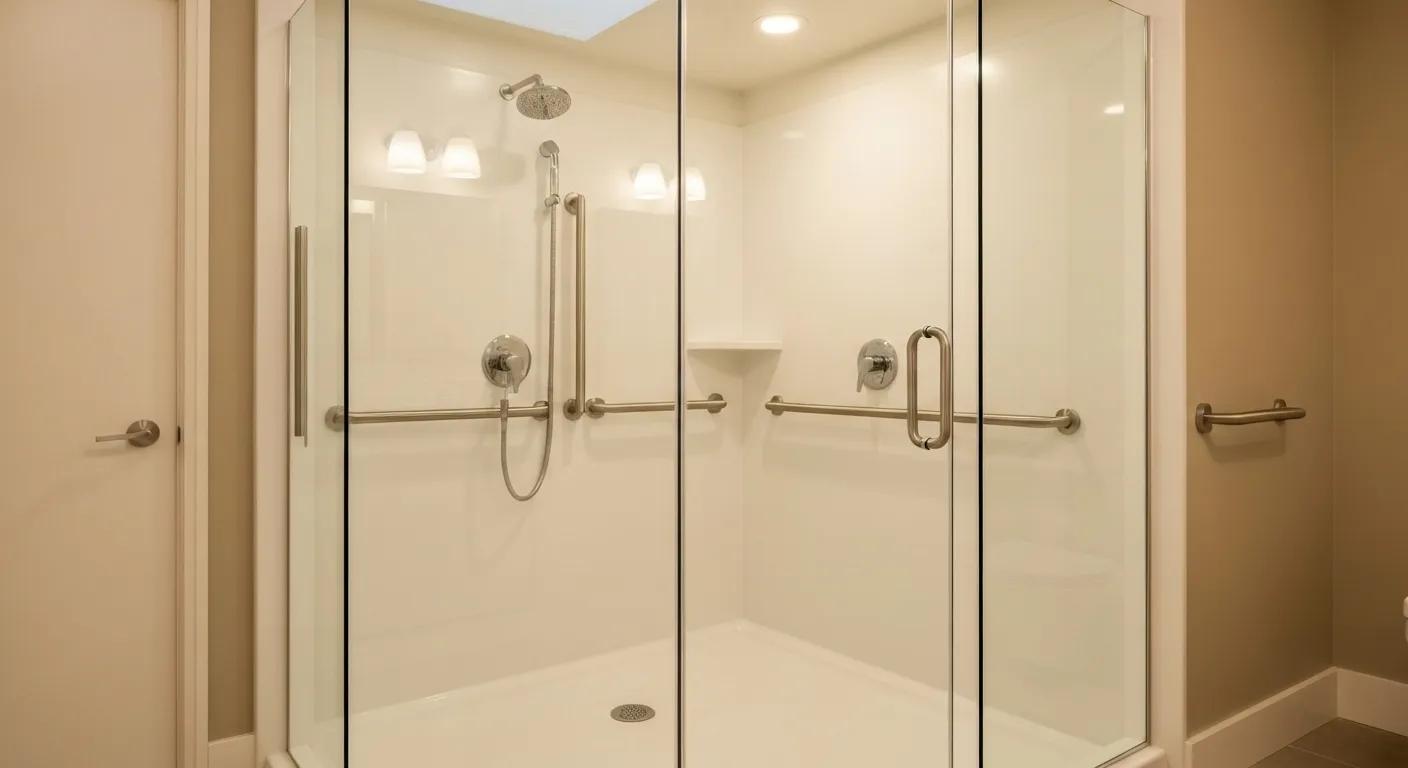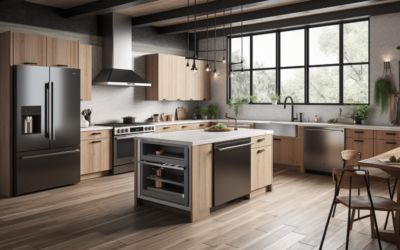Affordable Home Modifications for Safer Living: Essential Solutions and Funding for Aging Adults
Every year, one in four adults over 65 experiences a fall at home, demonstrating why affordable home improvements for aging adults are crucial for independence and safety. This guide explores cost-effective modifications—from grab bars and non-slip flooring to ramps and lighting upgrades—then outlines funding options, the importance of aging in place, and practical DIY versus professional solutions. You’ll learn:
- What low-cost modifications prevent falls and enhance mobility
- How grants, loans, and non-profits make adaptations affordable
- Why aging in place relies on targeted home improvements
- Key bathroom, kitchen, and entryway upgrades and their costs
- When to tackle projects yourself and when to call a specialist
Through our referral network for home services (Home Modifications for Seniors), you can connect with vetted contractors who specialize in safe, budget-friendly renovations.
Home Modification Benefits for Seniors
Home modifications, such as installing grab bars and ramps, can significantly reduce fall risks and improve the quality of life for seniors. These adaptations promote independence and allow older adults to remain in their homes longer, enhancing their overall wellbeing.
Centers for Disease Control and Prevention (CDC), “Falls Among Older Adults” (2024)
This research supports the article’s emphasis on the importance of home modifications in creating a safer living environment for seniors.
What Are the Most Affordable Home Modifications for Seniors and Aging Adults?
Most affordable home modifications combine simple safety hardware, improved surfaces, and clear pathways to reduce fall risk and promote independence. These solutions require minimal structural work and deliver immediate benefits in stability, visibility, and mobility. Common low-cost adaptations include grab bars, handrails, non-slip mats, ramps, enhanced lighting, and decluttering.
Which Home Improvements Prevent Falls and Enhance Safety?
Targeted fall-prevention improvements create a stable environment and support daily activities.
- Install grab bars and handrails at key locations for secure support.
- Appnonslipnonslipnonsliplip flooring or mats to reduce slip hazards.
- Add ramps and threshold ramps for unimpeded wheelchair or walker access.
- Upgrade to brighter, glare-free lighting for better visibility.
- Remove tripping hazards by decluttering hallways and entryways.
These measures together reduce fall incidence, increase confidence, and lay the groundwork for more extensive adaptations.
How Do Grab Bars, Handrails, and Nonslip Flooring Improve Bathroom Safety?

Grab bars, handrails, and non-slip flooring create a safe bathing zone by providing stable handholds and traction underfoot.
- Recommended placements include beside the toilet, inside and outside the shower, and along tub walls.
- Materials range from stainless steel bars with textured adhesiveslipnon-slipsliplip vinyl strips rated for wet areas.
- Handrails in hallways and on staircases enhance balance during transfers.
By preventing slips and offering reliable support, these products directly reduce bathroom fall risks and promote independent bathing.
What Are Cost-Effective Mobility Aids Like Ramps and Stair Lifts?
Ramps and stair lifts bridge elevation changes to maintain access to all home areas.
- Ramps: Modular threshold ramps and custom-built wood or aluminum ramps meeting a 1:12 slope cost $150–$1,500 depending on length and materials.
- Stair Lifts: Straight-rail stair lifts range from $2,000 to $4,500, while curved rail systems can cost $8,000–$12,000.
These mobility aids eliminate barriers, enabling wheelchair users and those with limited strength to move safely between levels.
How Can Lighting and Decluttering Reduce Home Hazards?
Improved illumination and clutter removal enhance situational awareness and clear walking paths.
- Replace low-watt bulbs with LED fixtures that deliver 800–1,200 lumens per room.
- Install motion-sensor night lights along hallways and staircases.
- Remove loose rugs, electrical cords, and clutter from walkways.
- Use cord organizers and secure area rugs with nonslippery material.
Clear, well-lit spaces prevent trips and falls while supporting smooth transitions between rooms.
How Can Seniors and Disabled Individuals Fund Affordable Home Modifications?
Funding home adaptations often combines government grants, loans, non-profit assistance, and local programs to offset renovation costs.
Funding Options for Home Modifications
Various programs, including government grants and non-profit assistance, are available to help seniors afford home modifications. These funding sources can cover the costs of essential safety upgrades, making homes more accessible and safer for aging adults.
U.S. Department of Housing and Urban Development (HUD), “Home Modification Programs” (2023)
This citation provides information on the availability of financial assistance for home modifications, which aligns with the article’s discussion of funding options.
What Government Grants and Loan Programs Are Available?
Many federal programs provide direct financial support or low-interest financing for home safety upgrades.
| Program | Eligibility | Assistance Type |
|---|---|---|
| USDA Section 504 Home Repair | Low-income homeowners in rural areas ≥62 years | Grants up to $10,000 |
| VA Specially Adapted Housing | Veterans with service-connected disabilities | Grants up to $100,896 |
| Medicaid HCBS Waivers | Low-income adults with qualifying needs | Covers safety and accessibility |
| FHA Title I Home Improvement | Homeowners with a≥580 FICO score | 20-year fixed-rate loans |
Which Non-Profit Organizations Offer Home Modification Assistance?
Non-profits partner with communities to provide free or low-cost repairs and installations.
- Rebuilding Together coordinates volunteer labor to install ramps, grab bars, and safety lighting.
- Habitat for Humanity’s A Brush with Kindness program repairs steps, walkways, and handrails.
- Local area agencies on aging often distribute minor repair vouchers for disabled and low-income seniors.
These organizations fill funding gaps and deliver hands-on support.
How Do State and Local Funding Programs Support Home Safety?
Many states supplement federal aid with targeted grants and low-interest loans. For example:
- California’s CARES program offers up to $5,000 per household for fall-prevention installations.
- Illinois Home Repair Program provides zero-interest loans for accessibility improvements.
- County area agencies on aging distribute emergency repair funds for urgent safety hazards.
Local resources frequently require residency and income verification, but can cover materials and labor.
What Are the Eligibility Criteria and Application Processes for Funding?
Most programs share common requirements:
- Age or Disability Verification: Proof of senior status or medical need.
- Income Limits: Household income below program thresholds.
- Homeownership: Applicants must own and occupy the property.
- Assessment: A professional home safety evaluation often precedes funding.
- Documentation: Submit proof of income, homeownership, and contractor estimates.
Applicants complete forms, secure contractor bids, and coordinate inspections before receiving funds.
Why Is Aging in Place Important and How Do Home Modifications Support It?
Aging in place means living comfortably and independently at home as one grows older, which enhances mental wellbeing and stretches retirement savings.
What Does Aging in Place Mean for Seniors’ Independence?
Aging in place empowers seniors to maintain control over daily routines, social connections, and familiar surroundings without relocating. This continuity supports emotional health and reduces the stress of institutional living.
How Do Home Modifications Reduce Fall Risks and Improve Quality of Life?
Targeted adaptations—like lever handles, curb-free showers, and secure handrails—directly address common fall hazards. By minimizing accident risk, seniors experience greater confidence, mobility, and overall life satisfaction.
What Role Do Occupational Therapists and Certified Specialists Play?
Occupational therapists (OTs) and Certified Aging-in-Place Specialists (CAPS) conduct assessments to identify risk factors and recommend tailored modifications. Their expertise ensures that installations meet individual needs and adhere to safety standards.
What Are the Key Bathroom Safety Modifications for Safer Living?
Bathrooms pose one of the highest fall risks; strategic modifications transform them into secure, accessible spaces.
How Are Grab Bars Installed and Where Should They Be Placed?
Grab bars require solid-stud mounting at 33–36 inches above the floor. Installations typically include:
- Sidewall: Next to the toilet for sit-to-stand support.
- Shower/Tub Entry: Horizontal bar near the threshold for stability.
- Shower Interior: Vertical or angled bar to assist standing and transfers.
Proper placement ensures optimal leverage and balance during bathing.
What Are the Benefits and Costs of Walk-in Showers and Tubs?
| Option | Average Cost | Key Advantage |
|---|---|---|
| Prefabricated Unit | $2,500–$5,000 | Quick installation, sealed pan |
| Custom Curbless Shower | $7,000–$15,000 | Seamless design, unlimited width |
| Walk-in Tub | $5,000–$12,000 | Hydrotherapy jets, built-in seat |
How Non-Slipping Ooring Prevents Bathroom Falls. Nonslippery ooring relies on textured surfaces that increase friction under wet conditions. Common materials include rubber tiles, anti-slip vinyl planks, and treated porcelain tile with grit additives. These surfaces maintain traction even when soapy or damp.
Why Use Raised Toilet Seats and Safety Frames?
Raised toilet seats and frames reduce knee and hip strain during sits and stands. Seats add 2–6 inches of height while frames provide lateral support. Together, they enhance ease of use and decrease the risk of losing balance.
How Can Kitchen Accessibility Upgrades Improve Safety and Independence?

Kitchen modifications promote safe meal preparation and reduce strain during cooking tasks.
What Are Affordable Solutions Like Lowered Counters and Pull-out Shelves?
Lowering a section of countertop to 30–34 inches from 36 inches provides wheelchair access. Pull-out shelves and lazy-Susan inserts improve reach to cabinets without bending or stretching.
How Do Easy-Grip Faucets and Accessible Appliances Help Seniors?
Lever-style faucets require less wrist strength than knobs. Side-opening ovens, front-control cooktops, and drawer dishwashers position controls within easy reach, minimizing slips and burns.
What Are the Cost Ranges for Kitchen Accessibility Upgrades?
- Lowered countertop installation: $200–$800 for a single section.
- Pull-out cabinet shelves: $100–$300 per cabinet.
- Easy-grip faucet retrofit: $50–$150.
- Accessible appliance upgrade: $600–$1,500 per unit.
These investments enhance safety while remaining budget-friendly.
What Entryway and Mobility Improvements Enhance Home Accessibility?
Entryway and hallway adaptations ensure barrier-free movement throughout the home.
How Do Wheelchair Ramps and Stair Lifts Improve Mobility?
Wheelchair ramps with a 1:12 rise ratio allow smooth transitions over steps. Stair lifts provide motorized seating along stair rails, enabling users to access upper floors independently and safely.
Why Widen Doorways and Install Lever Handles?
Widening doorways to 32–36 inches accommodates wheelchairs and walkers. Lever handles replace knobs to require minimal grip strength and remain operational under limited dexterity conditions.
What Are the Installation Costs and Funding Options for Mobility Aids?
- Threshold ramps: $150–$400.
- Modular aluminum ramps: $500–$2,000.
- Stair lifts: $2,000–$12,000.
- Lever handle retrofit: $30–$70 per door.
These expenses may qualify for grants, loans, or non-profit assistance detailed above.
When Should Seniors Choose DIY Home Modifications vs. Professional Installation?
Balancing cost savings and safety determines whether a project is suitable for DIY or requires expert help.
What Are Simple, Low-Cost DIY Safety Upgrades?
- Installing adhesion strips in bathtubs and showers.
- We are swapping out low-watt bulbs for brighter LED lighting.
- Securing loose rugs with double-tape or slip underlay.
- Adding motion-sensor night lights along corridors.
These tasks typically cost under $100 and improve safety immediately.
When Is Professional Help Recommended for Home Modifications?
Complex structural changes—such as cutting into walls for bar installation, custom ramp construction, and major plumbing work for walk-in showers—require licensed contractors and certified specialists to ensure compliance with building codes and ADA guidelines.
How to Find Certified Aging-in-Place Specialists and Occupational Therapists?
Search for Certified Aging-in-Place Specialists (CAPS) through the National Association of Home Builders directory and locate occupational therapists via local area agencies on aging. Our Home Modifications for Seniors referral network connects you with vetted professionals who deliver safe, code-compliant installations.
Seniors who adopt these targeted modifications experience fewer falls, more independence, and greater confidence to remain in the comfort of their own homes. By combining simple upgrades, strategic funding, and expert guidance, aging adults can enjoy a safer living environment without breaking the budget.
References
https://www.rd.usda.gov/programs-services/single-family-housing-programs/single-family-housing-repair-loans-grants
https://grants.gov/search-results-detail/356487
https://www.hud.gov/helping-americans/home-improvements
https://rebuildingtogether.org/safe-at-home
https://www.payingforseniorcare.com/home-modifications/how-to-pay-for-home-mods
https://www.discover.com/online-banking/banking-topics/how-to-pay-for-home-modifications-for-disabilities/
https://www.theinspectiongroup.com/huds-older-adult-home-modification-program/
https://www.nerdwallet.com/article/loans/personal-loans/accessible-home-modification-grants
https://www.va.gov/housing-assistance/disability-housing-grants/
https://www.lifewaymobility.com/resources/medicaid-home-modifications-funding-guide/
https://www.hud.gov/contactus/healthy-homes-grants





